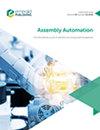基于工业异构数据的产品质量管理KPI可视化系统
IF 1.7
4区 计算机科学
Q3 AUTOMATION & CONTROL SYSTEMS
引用次数: 1
摘要
目的质量管理系统通常用于满足离散制造业对产品质量日益严格的要求。然而,传统的经验驱动的质量管理方法无法处理来自多个来源的异构数据,导致信息孤岛。本研究旨在提出一个质量管理关键绩效指标可视化(QM-KPIVIS)系统,以实现综合质量控制,并最终确保产品质量。设计/方法论/方法基于多个异构数据,提出了一种集成方法来明确量化物联网数据与产品质量之间的关系。具体而言,本研究基于多个异构质量信息树确定了质量问题的跟踪路径。此外,采用层次分析方法计算质量控制过程中质量影响因素的关键绩效指标。FindingsProposed QM-KPIVIS系统由数据可视化、质量问题处理、质量优化和用户权限管理模块组成,这些模块以良好的协调方式运行。还进行了实证研究以验证所提出的系统的有效性。独创性/价值据作者所知,本研究首次尝试使用工业物联网和多源异构数据进行集成产品质量管理。与传统的经验驱动的质量管理方法相比,所提出的方法更方便用户,更直观,并已初步应用于制造业。本文章由计算机程序翻译,如有差异,请以英文原文为准。
An industrial heterogeneous data based quality management KPI visualization system for product quality control
Purpose
Quality management systems are commonly applied to meet the increasingly stringent requirements for product quality in discrete manufacturing industries. However, traditional experience-driven quality management methods are incapable of handling heterogeneous data from multiple sources, leading to information islands. This study aims to present a quality management key performance indicator visualization (QM-KPIVIS) system to enable integrated quality control and ultimately ensure product quality.
Design/methodology/approach
Based on multiple heterogeneous data, an integrated approach is proposed to quantify explicitly the relationship between Internet of Things data and product quality. Specifically, this study identifies the tracing path of quality problems based on multiple heterogeneous quality information tree. In addition, a hierarchical analysis approach is adopted to calculate the key performance indicators of quality influencing factors in the quality control process.
Findings
Proposed QM-KPIVIS system consists of data visualization, quality problem processing, quality optimization and user rights management modules, which perform in a well-coordinated manner. An empirical study was also conducted to validate the effectiveness of proposed system.
Originality/value
To the best of the authors’ knowledge, this study is the first attempt to use industrial Internet of Things and multisource heterogeneous data for integrated product quality management. Proposed approach is more user-friendly and intuitive compared to traditional empirically driven quality management methods and has been initially applied in the manufacturing industry.
求助全文
通过发布文献求助,成功后即可免费获取论文全文。
去求助
来源期刊

Assembly Automation
工程技术-工程:制造
CiteScore
4.30
自引率
14.30%
发文量
51
审稿时长
3.3 months
期刊介绍:
Assembly Automation publishes peer reviewed research articles, technology reviews and specially commissioned case studies. Each issue includes high quality content covering all aspects of assembly technology and automation, and reflecting the most interesting and strategically important research and development activities from around the world. Because of this, readers can stay at the very forefront of industry developments.
All research articles undergo rigorous double-blind peer review, and the journal’s policy of not publishing work that has only been tested in simulation means that only the very best and most practical research articles are included. This ensures that the material that is published has real relevance and value for commercial manufacturing and research organizations.
 求助内容:
求助内容: 应助结果提醒方式:
应助结果提醒方式:


